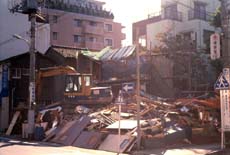index
Intentional links and meaning
click on images for full-size:





Intentional adjacency meaning (Ebisu Garden Place, Tokyo)

Adjacency and change of meaning (Himeji, Japan)

Adjacent space changing in uncontrollable ways

A temporary place
What makes the "spatiality" or connectivity of a hypertext different from a suburb is that in the hypertext all connections are intentional. Links are made. There is no parallel to the chance juxtapositions and chance meaning effects that occur in physical space (and could occur in a large enough virtual space). So all hypertext connections take on intentional meaning and effects. If I build a McDonald's next to a music store, I may have no intention that the relation between the two be meaningful. The site for my restaurant became available through causes that had nothing to do with the adjacent music store. However, though unintended, the association and contrast of the two will still be meaningful. Philosophers from Hobbes to Derrida have pointed out that there is no stopping the generation of meaning by contiguity. Such meaning effects may not have been specially intended, nor need they be taken as rhetorically or normatively important (unless the local store owner wants to use them in some way, perhaps for publicity). But the effects will be there nonetheless. On the other hand, in a standard node-and-link hypertext, nothing is next to anything else until a link is created. There are no unavoidable and uncontrollable adjacencies such as occur in physical space. Yet, even in a hypertext, we do have to distinguish between links that are intentional and which, though they have some meaning effects, had been made for other purposes, perhaps to ease navigation, from links that have particular rhetorical effects, and both of these need to be distingushed from links that are normatively important. Suburbs are more like established texts with normatively prescribed readings. But our places are never totally set, for many reasons, including the fact that spatial possibilities exceed any link or normative structure. In addition, some contemporary places are becoming especially fluid, made on the fly, more like temporary work groups than the settled institutions.